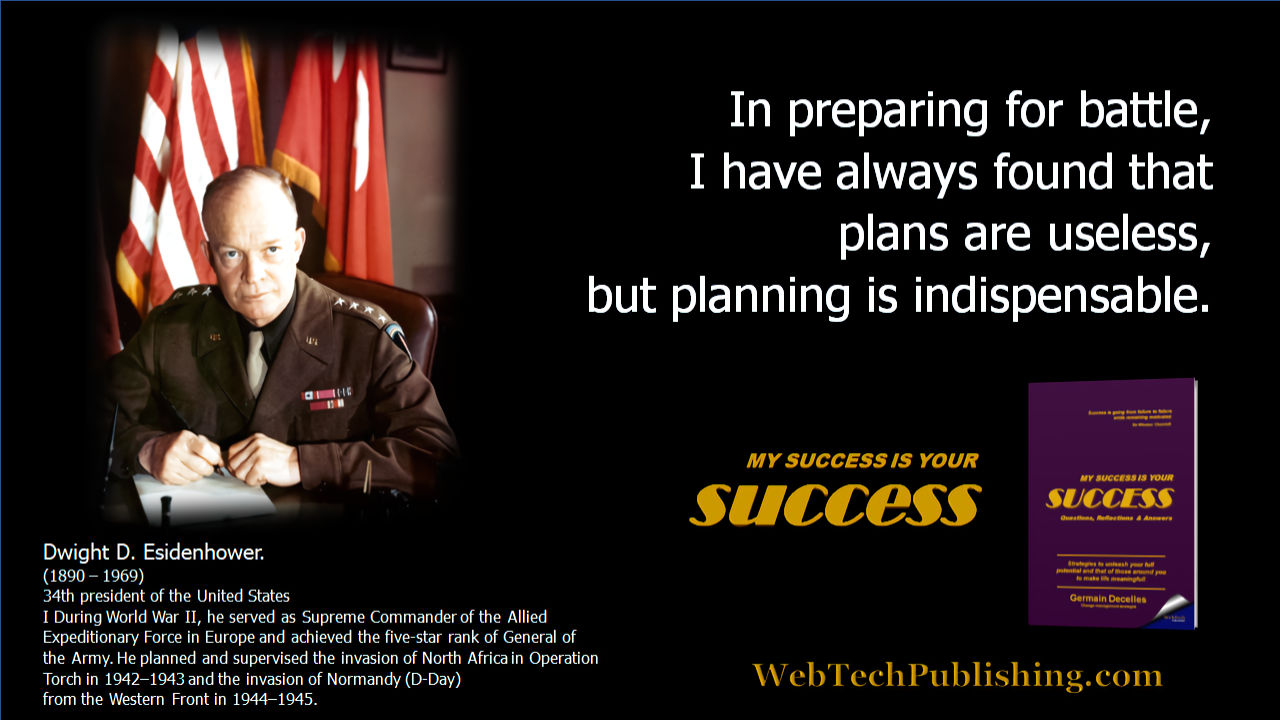|
Article published on LinkedIn.com:
April 05, 2024
33_strategic_success_En.pdf

The quotations, short texts, and photographs in this
work remain the exclusive property of their respective
authors.
STRATEGIC SUCCESS
Traditionally, the military uses the word « strategy. »
Strategy refers to the "deployment" of troops. It expresses
the positioning of the troops before the enemy is engaged.
Today, this word is used in several sectors and types
of activities. To facilitate the context of the use of the
word, it is a question of substituting « resources » for
troops.
A strategy is an action that managers take to achieve business
or organizational goals.
A strategy can also be defined as a general direction set for
the business and its various components to achieve a desired
state in the future.
1.
The strategy is derived from a detailed strategic planning process: a strategy consists of integrating the organizational activities and
using and allocating the necessary resources within the
organizational environment, in order to achieve the
objectives.
When planning a strategy, it is essential to consider that
decisions are not made in a vacuum and that any action taken,
is likely to provoke a reaction from the people concerned,
competitors, customers, employees, suppliers, and society at
large.
A strategy can also be defined as the knowledge of goals, the
uncertainty of events, and the need to consider the likely or
actual behavior of others.
A strategy is an organization's decision plan that sets out
its objectives, policies, and key elements for achieving the
objectives.
In addition, it defines the business or goals to be pursued,
the type of economic and human organization it wants to be and
the contribution it expects, to make, to its shareholders,
customers, and society as a whole.
A strategy is meaningful because it is
not possible to predict the future. Without perfect foresight,
organizations must be prepared to deal with the uncertain
events that constitute the environment in which they operate.
A strategy deals with long-term
developments rather than routine operations, that is, it deals
with the likelihood of innovations or new products, new
production methods, new markets to be developed or social
policies in the future.
2.
How to elaborate a strategy?
Many leaders find it difficult to adopt a
strategy. They know well that it is important to have
strategies, in order to logically present the decision-making
in their organizations.
They understand that they cannot observe and control
everything in their organizations, contrary to what many of
them would like.
They sincerely want to develop good strategies and they
understand the theory. But when it comes to detailing the
strategy, they quickly get bogged down.
It's unfortunate, but it's not that surprising. This is a
direct consequence of the confusion over what an «
organizational strategy » is and is not.
An organizational strategy is a set of guiding principles
that, when communicated and adopted in the organization,
generate a desired decision-making model.
A strategy is therefore about how people in the organization
should make decisions and allocate resources in order to
achieve key objectives.
A good strategy provides a clear roadmap, made up of a set of
guiding principles or rules, that defines what actions
employees should or should not take and what they should
prioritize or not to achieve the desired goals.
So, a strategy is just one piece of the overall strategic
direction that leaders need to set for their organization.
A strategy is not a mission, unlike what the leaders of the
organization want it to accomplish. The missions are developed
into specific objectives and performance measures.
A strategy is also not the value network that includes the
network of relationships with suppliers, customers, employees,
and investors within which the business creates and captures
economic value.
Finally, a strategy is not a vision, which is an inspiring
portrait, of what pursuing and achieving the organization's
mission and goals will look like.
Vision is part of the incentives of what leaders do to
motivate members of the organization to engage in
above-average efforts and the mission is about what will be
accomplished.
The value web is about the people with whom value
will be created and captured.
A strategy addresses how resources should be
allocated to accomplish the mission within the context of the
network value. And a vision that includes incentives, explains
why members of the organization must feel motivated to perform
at a high level.
Together; mission, networks, strategy, and vision
define the strategic direction of an organization.
They provide, the WHAT, WHO, HOW and WHY
needed to powerfully align action during complex structuring.
Simple, you cannot develop a strategy for your
business or organization without first thinking about the
mission and goals.
Similarly, one cannot develop a coherent strategy by
isolating oneself from decisions concerning the network of
partners with which the organization will create and capture
economic and social value and even in some cases both in
parallel or sequentially.
By focusing on the four elements and sequencing them
correctly, the strategy building process can be demystified.
3.
Which strategy to choose?
A strategy is the collective term for all the steps that a
business or organization takes to achieve its goals and
achieve its mission and vision.
This involves understanding what the business or organization
does, what it needs and what it needs to do to achieve those
goals.
This information helps in making decisions about resource
allocation and helps in setting priorities.
When everyone in the organization understands the strategy, it
creates a framework for the team to keep working in the same
direction.
Strategic decisions will guide your business or organization
in the direction you are working towards.
However, with so many ways to do it, it's important to keep
your vision in mind.
Here are some guiding questions to ask yourself and your team
along the way:
·
Who are we?
·
How to stand out?
·
Where do we want to go in the future?
Once you have an overview of your goals, refine your questions
to focus on the most immediate goals that will help you
achieve them.
Make sure you stay realistic by keeping your action plan
within the limits of your available resources, your user base,
and the specific needs of your market.
Here are some business strategies to consider:
a.
Structuralist:
By adopting a structuralist strategy, you will build your
business, political, or social operations around current
market conditions and use industry structure to your
advantage.
For example, in a business this may mean that you order
products or supplies using established processes from your
suppliers, or that you take into account generally recognized
barriers.
b.
Growth:
if you choose a growth strategy, it means that you focus on
introducing new products or features or expanding into new
markets.
To do this, you will seek, for example, a competitive
advantage by offering a unique experience that your potential
customers will not find anywhere else. Or you will find a new
clientele through market research or professional networking.
This is when you need to consider a growth strategy for your
business.
c.
Competitive price:
becoming a cost leader is one way to set yourself apart by
offering a competitive price for your product or service.
If you have a unique strategy to reduce costs without
sacrificing quality, use it to stand out in your industry.
There are many
benefits to being a cost leader, including.
• Leaders can
charge the lowest amount for a product and still be
profitable.
• Leaders can
withstand recessions better than their competitors because
they are experienced in attracting consumers with budgets in
mind.
• Leaders can be
more flexible. Since their costs are low, they can reduce
prices more often to attract a larger customer base.
Note that a cost containment strategy carries several risks.
If a competitor can cut costs more frequently, it could take
away your customers.
d.
Differentiation:
with a truly
unique product or service that you can offer to potential
customers, you can stand out in the market. Differentiation
allows a business to take a creative approach and charge high
prices for products or services.
Strategies to drive brand differentiation include emotional
response, innovation, creative presentation, unique
experience, and pricing.
Product differentiation is important because it can lead to a
competitive advantage in the market.
If
differentiation were not an option for small businesses, large
businesses would still dominate, as they have the opportunity
to set the most attractive price.
e.
Inflate prices: Price inflation
strategies involve charging a high price for your product or
service upfront to cover upfront costs such as production,
manufacturing, and marketing.
Usually, this approach makes sense for a company introducing something
that has never been done before and is worth a premium price.
The advantages of a pricing policy are the ability to make a product
attractive to customers, while covering costs.
The downsides of pricing strategies that aren't appealing enough to
customers won't provide, the revenue, you need to operate
successfully.
f.
Acquisition: acquisition
strategies are a way to drive growth through the purchase of
another business. This is different from an organic growth
strategy, where the focus is on growing internal products or
services.
Here are some reasons to pursue the acquisition of another
company:
·
Obtain quality personnel or additional skills,
knowledge of your industry and sector or other business
information.
·
Access funds or valuable assets for new
development.
·
Attract a larger customer base, increase your
market share and reduce competition.
·
Diversification of products or services.
·
Reduced costs and overhead through shared
budgets.
Above all, remember that acquiring a business can be extremely
complex. Make sure you have legal, finance, organizational and
marketing professionals on your team.
-
To concentrate:
the idea behind
targeted approaches is that you can choose the segment of
the market you want to target through one of the
strategies already covered.
If
you see an opportunity to be a leader in a specific area,
focus and focus your efforts on pursuing it.
Sometimes it can pay off more than trying to capture the
entire market with a targeted strategy.
When deciding on a new
business strategy, your first step should be to review your
business plan.
You will learn about your
strengths, weaknesses, competitive challenges, and resource
allocation.
This information can help
you craft the most effective business strategy for your unique
business.
To learn more about how to inspire success, visit WebTech
Management and Publishing Incorporated (www.webtechmanagement.com)
and click on the blue image (Wise whiZ) at the bottom right of
the screen.
|

|
This book is the result of forty years
of experience acquired with local and international
organizations and companies and during consultancy,
change management, transition and marketing services.
This 404-page
personal development book was published by WebTech
Publishing and is available online in English, North
American French and European versions. For more
information and to view the flip book, visit
webtechPublishing.
|
About the Author
Decelles
Other publications:
ISO Pour Tous
– Le manuel
d’information ISO – Le guide de préparation ISO – La
gestion du changement en affaires – La gestion de
projet d’affaires – Le
changement POUR TOUS –
Change your future,
now! – Mon succès est votre succès.
Press Contact
Germain Decelles, o.s.j.
WebTech Management et Publication Incorpored
|
 |
—30 —
|